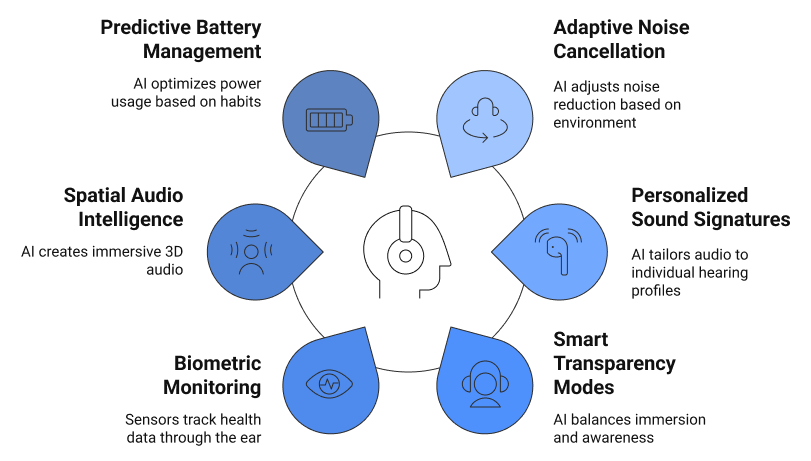
The audio industry has undergone a dramatic transformation with AI integration. Modern audio devices now function as intelligent companions that understand user preferences, environmental context, and usage patterns to deliver personalized sound experiences that were impossible just a few years ago.
The key to successful AI implementation in audio devices lies in understanding that every listening scenario is unique. Whether someone is commuting on a noisy train, working in a quiet office, or relaxing at home, the optimal audio experience requires real-time adaptation to both environmental conditions and user preferences.
This level of sophistication demands AI systems that can process multiple data streams simultaneously while maintaining the low-latency performance that audio applications require.
In this part, we explore how AI is reshaping consumer expectations and redefining best-in-class features across five major categories: smart speakers, headphones, soundbars, streaming devices, and multi-room systems.
Smart Speakers & Voice Assistants
Smart speakers have grown from simple voice-activated devices into intelligent hubs that anchor entire smart home ecosystems. In today’s market, it’s not enough to just respond to commands – success depends on how well these devices understand context, adapt to environments, and personalize experiences in real time.

Must-Have Features:
- Contextual Voice Recognition – Understand Users, Not Just Commands
Today’s users expect more than wake word recognition. Advanced AI must distinguish between household members, track context across conversations, and adapt to different speech patterns throughout the day. This enables true personalization and eliminates the frustration of repeating commands when the system loses the conversational thread.
- Adaptive Audio Processing – Consistent Sound, Any Room
Speakers sound different in every environment. AI-powered adaptive processing continuously analyzes room acoustics, ambient noise, and content type – then adjusts frequency response and spatial effects accordingly. Whether it’s a carpeted bedroom or a tiled kitchen, users enjoy consistent audio quality without manual tuning.
- Intelligent Content Curation – Serve the Right Media at the Right Time
Instead of relying on likes or star ratings, modern systems use machine learning to analyze listening habits, skip behavior, volume changes, and time-of-day preferences. This allows speakers to recommend music, podcasts, or news content proactively – creating a more engaging, personalized experience users keep coming back for.
Advanced Features:
- Multi-Modal Interaction – Natural, Hands-Free Control
Combining voice with gesture recognition, proximity sensing, and visual feedback makes interactions more intuitive. Users can lower the volume with a wave, pause music by walking away, or get system status via LED indicators. This lowers cognitive effort and is especially useful when voice isn’t practical – like in noisy or multi-tasking environments.
- Emotional Intelligence – Understand and Adapt to Mood
By analyzing vocal tone, speech cadence, and word choice, smart speakers can detect emotional states like stress or fatigue. They respond by adjusting music, offering calming content, or softening their tone – turning a utility device into a subtle, proactive wellness companion.
- Predictive Automation – Anticipate, Don’t Just React
AI learns user routines over time and begins acting before it’s asked. It might start a morning news briefing automatically, lower the volume during usual meeting times, or play relaxing sounds as bedtime approaches. These small but thoughtful touches make the experience feel seamless and personalized – like the device just “gets” the user.
Headphones & Earbuds
The personal audio market has embraced AI as a key differentiator, with intelligent features becoming essential for premium positioning. Modern headphones and earbuds must deliver personalized experiences that adapt to individual hearing profiles, usage contexts, and environmental conditions.

Must-Have Features:
- Adaptive Noise Cancellation – Smarter Silence
AI-powered ANC goes beyond blanket noise reduction. It recognizes and responds to specific sound types – like steady engine hums, sudden car horns, or background chatter – using tailored cancellation strategies. The result? A quieter, more comfortable listening experience that adjusts instantly to changing environments.
Did you know: adaptive ANC can reduce perceived background noise by up to 80% in dynamic settings.
- Personalized Sound Signatures – Audio That Fits You
No two ears hear alike. AI-driven sound personalization analyzes each user’s hearing sensitivity, preferred frequencies, and listening habits to build a custom profile. This leads to dramatically improved perceived audio quality – often by 30–40%, especially in mid and high frequency ranges.
- Smart Transparency Modes – Safety Meets Awareness
Instead of just turning on or off, smart transparency adapts based on context. It lets in critical sounds – like sirens, alerts, or PA announcements – while still filtering out non-essential noise. For users moving between outdoor environments, transit, and offices, this balance between immersion and awareness is vital.
Advanced Features:
- Biometric Monitoring – Health Data from the Ear
Built-in sensors in earbuds can now track heart rate, temperature, and stress levels through the ear canal – an area known for accurate biometric readings. This enables fitness tracking, stress alerts, and even early health insights – without adding extra hardware.
- Spatial Audio Intelligence – Immersive on the Move
AI adjusts spatial sound in real time by tracking head movement and content type. Whether it’s movies, music, or virtual meetings, users get a 3D audio experience that feels dynamic and natural – ideal for premium and enterprise-grade audio products.
- Predictive Battery Management – Power When You Need It
Using behavioral data, the system predicts listening patterns and charging habits. It then fine-tunes power usage, ensuring the device lasts through high-use periods and reminds users to charge at optimal times – improving convenience without sacrificing battery health.
Soundbars & Home Theater Systems
Home theater audio has embraced AI to create more immersive and accessible entertainment experiences. Modern soundbars must deliver cinema-quality audio while adapting to diverse room acoustics and user preferences.

Must-Have Features:
- Room Correction AI – Great Sound, Any Space
No two rooms sound alike – but AI can fix that. Using built-in microphones or external sensors, room correction algorithms analyze room shape, surfaces, and speaker placement. The system then adjusts EQ, timing, and spatial audio output to suit your space – whether it’s an open-plan loft or a cozy bedroom.
According to Dolby Labs, properly calibrated room correction can boost audio clarity and spatial accuracy by over 40%.
- Content-Aware Processing – Optimized for What You Watch
AI now understands what you’re watching. It distinguishes between dialogue-driven drama, bass-heavy action, or complex musical performances – and automatically applies the best audio processing for each. Dialogue becomes clearer, explosions punchier, and music more immersive, without users lifting a finger.
- Intelligent Volume Management – Goodbye Loud Ads
Ever been jolted by a loud commercial or struggled to hear dialogue in a whispery scene? AI solves that. By normalizing perceived loudness across sources, boosting speech during quiet scenes, and smoothing dynamic range, the system keeps volume consistent and your remote untouched.
Advanced Features:
- Voice Isolation Technology – Clearer Conversations
Using AI-driven signal separation, the system isolates speech from background noise or music. That means crisper dialogue – even in chaotic battle scenes or noisy open living rooms. It’s especially valuable for users with hearing challenges or multi-generational households.
- Predictive Scene Analysis – Audio That Prepares Ahead
AI analyzes what’s happening on-screen in real time – then pre-adjusts the audio. For example, it can soften sudden explosions after a silent scene, or enhance ambient effects in a suspenseful moment. The result is smooth transitions and consistently engaging sound throughout a movie or show.
Streaming Audio Devices & Multi-Room Systems
Network-connected audio devices represent another category where AI creates significant value through intelligent content management and seamless multi-device coordination.
Must-Have Features:
- Intelligent Buffering – Smooth Playback Even on Busy Networks
AI predicts network congestion and adapts streaming quality in real time. By learning home internet patterns and pre-buffering content when needed, the system ensures consistent playback – even during peak usage or Wi-Fi hiccups.
- Cross-Device Synchronization – Seamless Multi-Room Audio
The system keeps music in sync across speakers in different rooms by adapting to device-specific delays and network latency. Users can move from kitchen to living room without missing a beat – literally.
- Content Discovery Intelligence – Personalized, Shared Listening
AI tracks listening habits across household members to suggest playlists, discover artists, and curate soundtracks aligned with user preferences and daily rhythms – no constant tweaking required.
Advanced Features:
- Environmental Audio Mapping – Smarter Sound Delivery and Detection
Multiple devices work together to map room acoustics and locate sound sources. This enables location-based volume adjustment, spatial audio effects, and even detection of unusual acoustic events like glass breaking or a smoke alarm.
- Behavioral Pattern Recognition – Automatic Audio Scheduling
The system learns daily routines and adjusts playback accordingly. Whether it’s upbeat music during breakfast, focused audio during work hours, or calming sounds at night – your audio follows your lifestyle without manual setup.
Developex: Your Partner in Advanced Audio Software Development
Building the next generation of high-performance audio products requires specialized software expertise that goes beyond off-the-shelf solutions. At Developex, we specialize in delivering the advanced software and system integration that power cutting-edge audio devices.
We provide end-to-end audio software development services to transform your concepts into market-ready, superior-quality products. Here’s how Developex can help you innovate:
- Custom DSP & Core Audio Development: We have core expertise in Digital Signal Processing (DSP) and building foundational audio software. Our team develops bespoke algorithms for features like adaptive noise cancellation, personalized sound signatures, and advanced voice processing, ensuring your product stands out with unique, high-performance capabilities.
- Embedded Development: For audio devices where low latency and real-time responsiveness are critical, we excel at optimizing software to run efficiently on the device’s embedded hardware. This ensures a smooth, reliable user experience and minimizes reliance on cloud processing.
- Firmware & App Integration: Our team ensures a seamless integration of all software components, from the low-level device firmware to the user-facing audio mobile applications. This guarantees a smooth and intuitive user experience that is both reliable and easy to use.
- Voice & Ecosystem Integration: Whether you’re integrating with existing voice assistants or building a custom solution, we handle the complex software architecture. We ensure your devices can seamlessly communicate with other products to enable cross-device synchronization and multi-room audio, creating a unified ecosystem for your users.
By partnering with Developex, you gain a dedicated team with a proven track record in audio software development. We help you create high-performance products that not only meet but exceed evolving consumer expectations, driving your success in the audio market.
Coming Next: AI in Smart Home & Environmental Devices
Audio AI represents one crucial component of the broader intelligent living revolution. In Part 3 of our series, we’ll explore how AI is transforming smart home devices – from thermostats and lighting systems to security cameras and appliances – creating comprehensive intelligent environments where audio devices work seamlessly with home automation systems to deliver truly anticipatory living experiences.
The convergence of intelligent audio with smart home AI promises to create living environments that understand not just what we want to hear, but when, where, and why we want to hear it, automatically orchestrating our complete sensory environment to support our daily lives.
Continue following this series to discover how AI features integrates with smart home to create the future of intelligent living.






